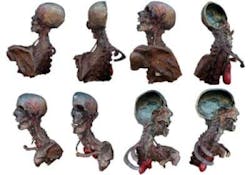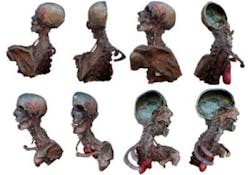3-D IMAGING: Off-the-shelf cameras and projectors team up for 3-D scanning
A number of different methods exist to generate 3-D image data. These include structured laser light-based systems, time-of-flight (TOF)-based methods, and projected structured light systems. Structured light projection using laser-based systems is often used to create high-resolution 3-D images; however, scanning the object requires that the object or camera system move across the object’s field of view. Alternate methods, such as TOF systems, can generate these 3-D models using a single camera with an embedded light source, although 3-D image resolution is far less than that of laser scanning-based systems.
In structured light projection systems, a visible light projector is used to project a series of intensity patterns with shifting periods across an object so that every subsequent pattern is offset by a fraction of its period with respect to the previous pattern. These phase-shifted images that are reflected from the object are captured by a camera and the relative phase map of the image is calculated. From this phase map, the coordinates of surface points in the image are also computed.
3-D image scanner
“In these systems, however,” says Aivaras Grauzinis, CTO at 3D Dynamics (‘s Gravenwezel, Belgium; www.3ddynamics.eu), “projected stripe patterns are not as small as a single pixel, resulting in ambiguous image data in regions of the image.” To overcome this problem, image data within these regions can be resampled using a sinusoidal pattern projected at higher frequencies over the striped regions. Resulting reflections from these projected images are then used to enhance the resolution of the final 3-D computed image.
Using these techniques, 3D Dynamics has created a 3-D image scanner called Mephisto that uses off-the-shelf projectors and cameras to generate 3-D images at 30 frames/s. After each camera and projector system is calibrated, a digital light projector (DLP) from InFocus (Portland, OR, USA; www.infocus.com) is used to project structured light patterns onto the object to be scanned.
As relatively low-resolution phase-shifted images are projected across the field of view (FOV) of the object, they are captured using a 1920 × 1080-pixel, CCD-based Pike F210B progressive-scan FireWire camera from Allied Vision Technologies (Stadtroda, Germany; www.alliedvisiontec.com).
As these images are captured, a 12-Mpixel EOS DSLR consumer camera from Canon (Tokyo, Japan; www.canon.com) is then also used to transfer sub-pixel data from sinusoidal patters projected across the phase-shifted images. The data are then transferred to the host PC over an HDMI interface. After image reconstruction, 3-D images are displayed on the PC monitor at 30 frames/s.
Color image capture
“For the system to capture color images using this technique,” says Grauzinis, “requires projecting RGB color planes and sinusoidal patterns across the image.” This results in a color 3-D rendition of the captured image (see figure). For digitizing solid objects in 360° 3-D, 3D Dynamics offers an optional turntable that can be directly controlled from the system’s user interface and synchronized with the cameras.
For larger or heavier objects such as the human body, up to nine Mephisto scanners can be networked to be controlled by a single PC. Already, the company’s scanner has found medical applications such as digitizing biological samples that are either dried in wax or conserved in formaldehyde. In the future, the company expects to develop even higher-speed, higher-resolution scanners as faster DLPs and cameras become available.

